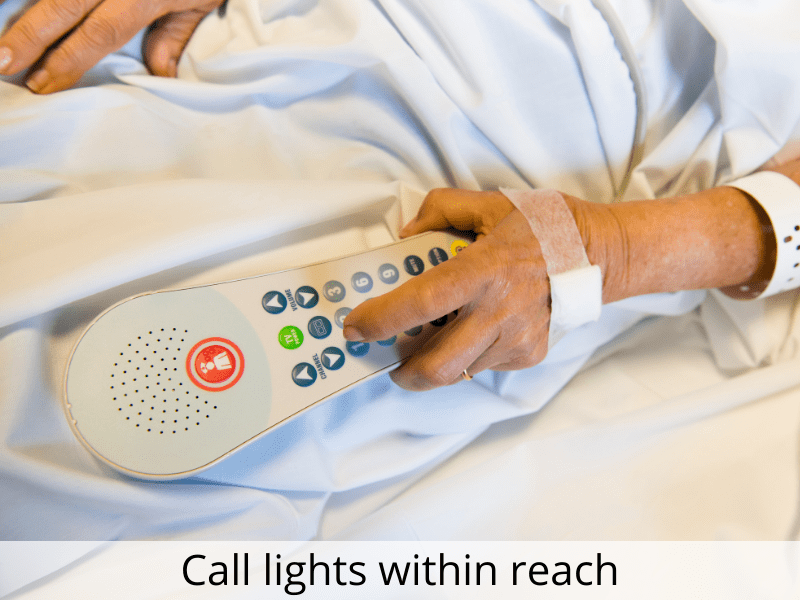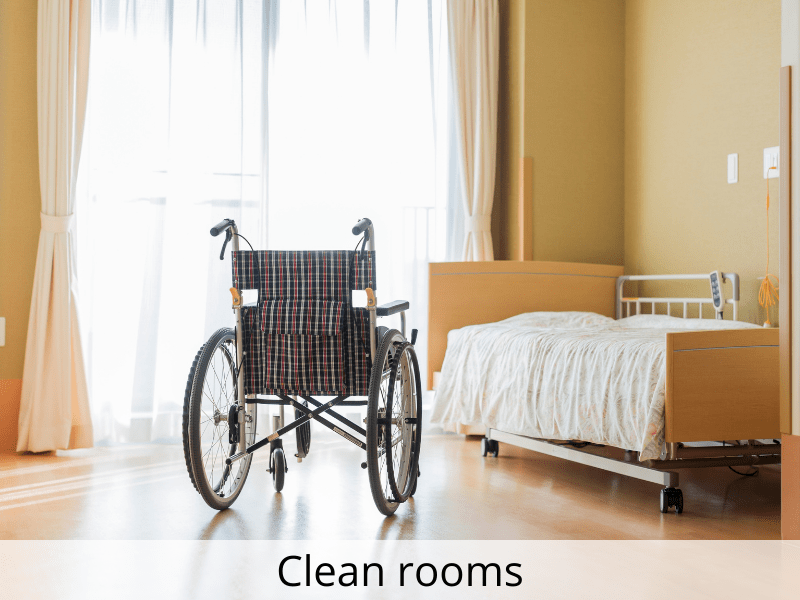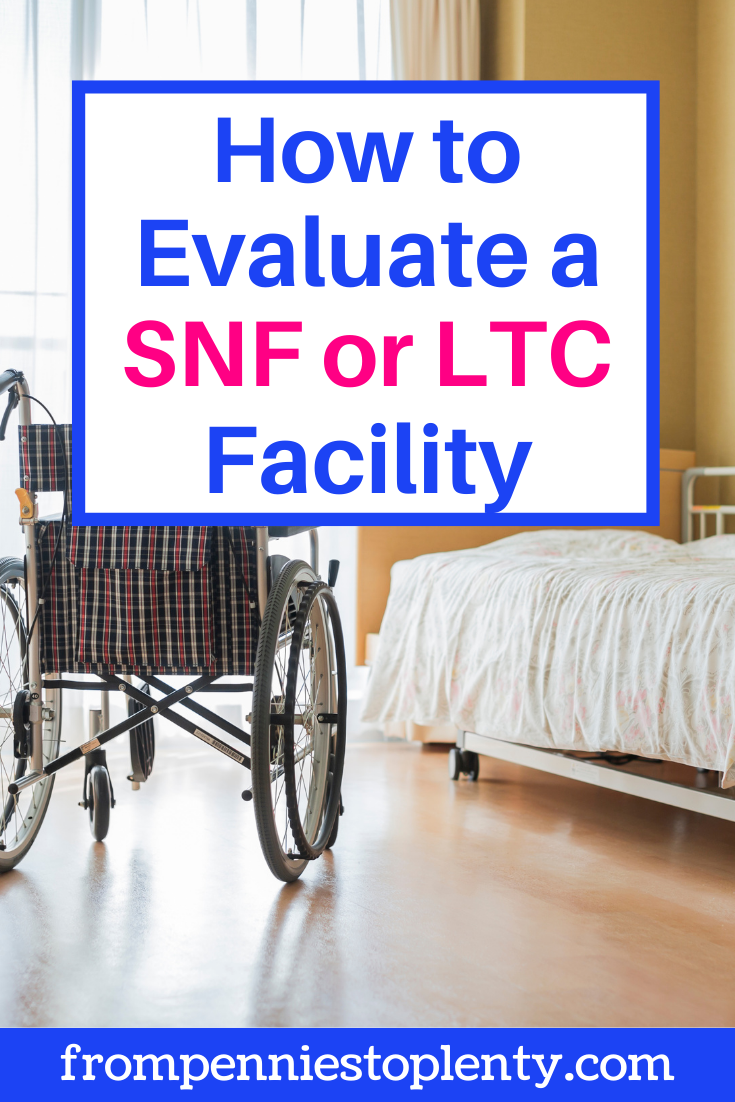How to Evaluate a Skilled Nursing & Long-Term Care Facility
I’ve worked in several skilled nursing and long-term care facilities over the years in my work as a medical speech-language pathologist. I’ve seen places that were poorly run and some that were well-maintained. After discussing these places with family and co-workers, I decided to share my thoughts and insight so that others without this experience can feel more confident analyzing these facilities to decide where to stay. This post covers how to evaluate a skilled nursing or long-term care facility for yourself or your loved one.
Disclosure: This post may contain affiliate links. This means that I may receive compensation when you click on a product link or purchase an item linked on this site. The content here is my opinion and should be considered as such. Please contact your doctor or other medical team members about your medical care. Click here for details.
Why do people stay in skilled nursing facilities?
A skilled nursing facility (SNF) is a place for people in need of skilled nursing. This means they need a certain level of medical care that requires trained nurses. Nurses and support staff such as certified nursing assistants (CNAs) are present 24 hours a day.
These people are not acutely ill, so they don’t need as much medical care as a hospital provides. But they are not well enough that they can return to their prior living situation.
They may have been living alone and doing all their daily care and management independently and can no longer do so. Or they may have been living with family members that are not able to take care of their medical and other needs.
Some examples of this:
A person with a stroke who completed rehab therapy in the hospital setting and was discharged to a SNF for continued rehabilitation and recovery.
A person in need of wound care
A person with tube feeding or percutaneous endoscopic gastrostomy (PEG) feeding
A person who is deconditioned from a respiratory condition such as COVID-19
Why do people stay in long-term care facilities?
All of the SNFs I’ve worked at provided both short-term stays and long-term stays. Short-term stays are for people who need temporary nursing care or rehab therapy. They are expected to improve enough that they won’t need SNF care after a while, and they have a plan to discharge elsewhere (usually home).
Long-term care residents live in facilities permanently. The facility is their home.
Short-term patients sometimes become long-term residents because they need a level of ongoing care that requires skilled nursing. They aren’t able to take care of themselves. They do not have family or caregivers that can provide them with the level of care they need at home.
In some cases, short-term stay patients become residents not because of medical need, but because they have no place to go after discharge. They may not have family and other resources for alternative living arrangements.
Most SNFs try to avoid taking patients without a discharge plan because they know they may be stuck with the patient after nursing needs and rehab therapy are completed.
Some examples of people who need long-term care:
A bedbound patient who develops pressure ulcers. Family is not able to turn the patient every few hours and care for the wounds. The ulcers can get worse.
A patient with a stroke may not have the cognition or mobility to be safe at home. Family cannot be with the patient 24/7. Therefore the patient has to live in a long-term care (LTC) facility.
I use the terms skilled nursing facility and long-term care facility interchangeably because the places I’ve worked had them both.
What should you look for when visiting a SNF or LTC facility?
I evaluate a SNF or LTC facility by asking myself if I would place my parent or grandparent there. These are some of the things I look for in determining my answer:
1 ) Call light response times
Patients and residents should each have a call light that is within their reach to call for help when they need them.
Some people will not have the cognitive or physical ability to use a standard small call light or call button. Some places may be able to accommodate this by providing a different type, one that can be activated with head, palm, or other body part movement or one with a larger surface area.
One SNF I’ve worked at offered call lights that were large and flat like a pancake for people who needed it. It wasn’t available when I asked for it at another SNF.
Then look at how long it takes for call lights to be answered. Long wait times happen. At the best places, the call light will usually be answered relatively quickly, which I consider about 10 minutes or less.
Sometimes a staff member will come in and ask what’s needed, turn off the call light, and either address the need or leave and have the person wait longer.
A few times I’ve done therapy sessions for over 30 minutes waiting for call lights to be answered the entire time.
The long waits are not always the staff member’s fault. Staffing is an ongoing challenge at all the SNFs I’ve worked at. Sometimes the staff member is the only one present in the area while other staff members are on break, and they need to closely supervise someone else (e.g., someone who’s a fall risk) or the patient’s request requires two people (e.g., transferring a patient who needs max assistance from a bed to chair).
Sometimes staff members are passing meal trays, cleaning or toileting another patient, or changing shifts. Sometimes the patient’s request is not that pressing at all like the person wants a newspaper or their hair brushed.
You want to see that call lights are regularly answered promptly and that patients’ and residents’ requests are addressed. It may not happen every time but it should happen most of the time.
2) Cleanliness of the place
Look at the cleanliness of the facility.
Are environmental services staff around taking care of the place?
Are garbage cans full or overflowing?
Are the floors, baseboards, and walls clean?
Does the place smell?
One facility I worked in had jack-and-jill bathrooms that always smelled. The bathrooms would often be dirty.
It’s a challenge when you have 4 or 6 people sharing one bathroom, but can be managed with good housekeeping. I worked at other places with jack-and-jill bathrooms that were well-kept and didn’t smell.
I’ve also worked in older buildings that looked like they were built in the ‘80s, yet I saw the place being cleaned frequently. So an older facility is not necessarily an unclean facility.
3) Cleanliness of the patients and residents
Patient and resident cleanliness is important to review because many people who live in these facilities need assistance with grooming and hygiene. A well-staffed facility with employees that are diligent about care will present patients and residents as best as possible.
Are residents dressed in normal clothes as opposed to gowns?
Are the clothes clean or dirty?
Are teeth clean like they’re getting frequent oral care?
Are fingernails cut and clean?
Is hair brushed?
Do incontinent and bedbound residents smell or complain of being wet from wearing adult diapers too long?
Know though that staff may be trying their best even if people look unkempt. Many residents do not like to have their teeth cleaned or to be showered and changed. They will fight tooth and nail against it.
Also, sometimes patients arrive at the facility without proper clothes (only a hospital gown) or their family brings them clothes that don’t fit or are difficult to put on.
At one facility, the protocol was to provide a large cloth bib or towel to every person at every meal. This may sound infantilizing but was an extra touch of the facility.
It was hugely helpful for keeping clothes and those being fed clean. Those who didn’t need it placed it on their laps like a napkin.
4) Staff engagement with patients and residents
Take a look at how staff members interact with the patients and residents. Interactions should reflect care for them. Some examples:
Talking to a resident before completing any action, such as speaking to a patient before pushing him or her elsewhere in the wheelchair.
Changing diapers or toileting a patient with the curtain drawn or door closed for privacy
Attempting to answer a reasonable question even if it’s to say they’ll look into it or it’s not possible rather than dismissing the question
Check out the facility activity schedule too.
Each facility has activities for patients and residents such as
Coffee or socialization hour
Current events discussion
BINGO
Arts & crafts
Exercise (usually light movement to music)
Trivia
Outings (to the museum, etc.)
You’ll want to take a look at how many people participate or are encouraged to participate in activities versus staying in their rooms or in bed. Some facilities are very active with many residents planning their days around the activities.
Of course, not everyone has the ability to participate in activities such as those who are bedbound or have advanced dementia. You still want to see a good amount of people participating or the staff members encouraging those who can to join in.
Note that many activities were canceled during COVID when residents had to remain in their rooms. Activities at some facilities may not have fully recovered.
If a facility is in lock-down, residents may have to eat in their rooms as the dining room may not be open. If the dining room is open, look at how many people eat with others there and how the staff feeds those that need feeding support.
5) Visit at various times of the day
Staffing can be very different at different times of the day or of the week. Visit during the day, later in the afternoon or evening, and during the weekend.
What differences exist in staffing between the various shifts?
How does staff at each shift interact with patients and residents?
How does staff act when the administration is not present? Do they seem happy?
Are staff members friendly with you, each other, and patients?
If you’re not able to visit, call at various times and see how long it takes for them to pick up the phone. How long does it take to receive a response to your question?
The nurses, CNAs, and administrators were very busy at every place I worked, so I don’t recommend needlessly bothering them, and know that it can take time to receive a call back.
But you do want to know that staff is responsive to your questions and concerns and that they will be addressed if you bring any up.
6) Staffing ratios
Facilities are required to meet state staffing mandates. For example, a state could require 20:1 patients to nurses and 10:1 patients to CNAs. The numbers may change depending on your state and the shift (day, evening, or night).
Unfortunately, I think the staffing mandates don’t always match the reality of how much care patients and residents need. If a CNA has multiple patients who need maximum support for everything including toileting and feeding, it’s difficult to get everyone else toileted, groomed, and out of bed in the morning in time for breakfast.
If you or a loved one is there to receive rehab therapy (physical, occupational, and/or speech therapy), ask about staffing in this area too.
Most of the places I’ve worked at had rehab staff through contract companies. Some companies had more therapist turnover than others.
Some companies were more supportive of meeting patient needs than others in terms of providing therapy, the amount of therapy provided, and available equipment. (More on this below.)
Staffing shortages are common among nurses, CNAs, and rehab staff. Some places handle it better than others. They have more substitutes or staff who are willing to work overtime.
One place I worked at had ongoing difficulty finding enough rehab staff so many patients received less therapy than was recommended. You can’t do therapy if there’s no one to provide it.
A patient might be recommended occupational therapy 5x/week but would receive it 2-3x/week because the one therapist on staff was stretched thin or the therapist could only come a few days a week. The therapist may have another job or another facility to cover.
If you or your loved one is going to a place for a specific reason such as physical therapy or wound care, make sure the place has the resources and staff available for it.
7) Meal options
The food options varied at every facility I visited, and this made a difference in how well many of the patients and residents ate.
Ask to see several weeks of menus and take a look at the meals the residents are eating if you’re there during a mealtime.
One facility provided relatively high-quality meals, four levels of solid foods (regular, bite-size, minced, puree), soup or broth with every lunch and dinner, and special requests such as fruit smoothies. The facility had many Asian residents so rice and rice porridge were available at every meal.
This facility had different types of liquids like milk, juice, tea, coffee, nutritional drinks, and even soda readily available. Other staff members and I could get them whenever we needed them or someone requested them.
This is a huge deal because dehydration is a major problem in facilities. Dehydration can lead to urinary tract infections and other health problems.
Sometimes lack of liquid intake is due to residents disliking the available drinks, not wanting to urinate as frequently, or simply not wanting to drink.
Sometimes it’s due to having drinks less available outside of meals or not enough staff or time to feed as much liquids as everyone needs.
That said, I would rate the food at every facility as decent or good. I’m somewhat particular about what I eat and how I like food prepared, and I thought the food at each facility was okay, at least for a short-term stay.
You can usually bring food for patients and residents.
Check with nursing if you want to bring anything. If you or your loved one receives speech therapy for swallowing issues, the food you bring should match the recommended diet.
For example, a patient may only be able to eat minced & moist solids (like ground food) because of a lack of dentition or swallowing impairment leading to a high risk of choking or aspiration (particles getting into the lungs).
You’d want to bring slightly blenderized food or ground meat versus a steak and French fries.
The facility I mentioned just above had full-size fridges just for patient food. Family members would tell staff when they brought something and label it. Then staff would heat it up for them at mealtimes.
Patients usually can order food delivery.
I’ve had some patients who had smartphones or knew how to use their cell phones to call restaurants for delivery. One woman had a large stack of takeout menus and coupons. She’d order chicken wings and breadsticks or Japanese food. I was so impressed!
Observe how much support residents get to eat their meals.
Beyond what food is available, many residents have a hard time accessing their meals and feeding themselves. They need assistance to sit up in bed, transfer to a chair, open food containers, obtain utensils, and eat the food safely.
How much support is given to those who need help setting up? Is there enough staff to feed everyone who needs to be fed?
8) Recent survey results
SNFs and LTC facilities must comply with certain requirements to receive payment under the Medicare or Medicaid programs. Surveyors come at least once a year unannounced to check that the facilities are in compliance.
Surveyors check everything about a facility. A few things I know about are
Infection control practices such as hand hygiene and use of gloves and other personal protective equipment
Facility sanitation
Food preparation in the kitchen (e.g., no expired food, clean equipment, meals match planned menus)
Medication management and administration
Patient positioning and management of contractures
Patient medical care
Request to see a copy of the facility’s most recent survey results. Every SNF and LTC will likely have some issues. Hopefully the infractions are minor so they are not in danger of causing patient harm.
A word about insurance types
During my time working in SNFs, patients that had traditional Medicare A received better rehab care than those with a Medicare replacement plan.
A Medicare replacement plan is one that is run by an insurance company such as Kaiser, Brown & Toland, Blue Cross Blue Shield, Cigna, and Chinese Community Health Plan. These are sometimes called advantage plans. There’s no advantage to them.
My patients with Medicare replacement plans tended to have shorter therapy sessions and less frequent therapy sessions. They discharged from rehab and the SNFs sooner than patients with traditional Medicare.
For my long-term care patients who had Medicare replacement plans, I needed prior authorizations to complete an evaluation and then another authorization to do treatment.
It was sometimes such a struggle to get authorization. There would be weeks in between the evaluation and treatment, which can be challenging and even dangerous for a patient such as one having swallowing problems.
I was often given only a few visits, say 6 total visits over 2 weeks of 30 minutes each. How is a stroke patient going to make meaningful progress with that little therapy?
This may have changed somewhat since a new classification system for reimbursement (the Patient Driven Payment Model) came into effect in 2019, but I still saw some of these issues afterward.
I’ve recommended that my parents get traditional Medicare A and B and a secondary insurance to cover the 20% co-pay.
But my parents don’t listen to me! They like the convenience of having the hospital, their doctors, and specialty clinics all in one place.
So ultimately you should pick the insurance plan that best fits your needs.
Wrap Up
I point out all these things about SNFs and LTC facilities not to be overly critical of them but to share what I think prospective patients and residents and their families need to know about them.
Finally, the employees of SNFs and LTC are some of the hardest working and most caring people I have ever met. They are often overworked, underpaid, and underappreciated.
It takes a certain type of person to do hands-on work on a memory ward where patients may hit and bite you. I’ve known CNAs out for back injuries from moving patients and one CNA with at least two surgeries stemming from work injuries or patients being combative. The work is very physical and injuries happen.
I hope you find a place that suits your needs with staff that cares for you or your loved ones as you want them to.







